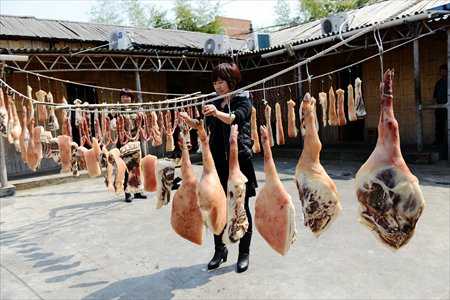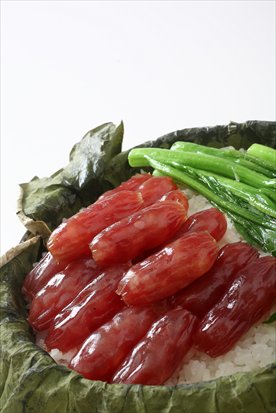The cure: air, salt and smoke

Two villagers in Zhejiang Province are sunning la rou. Photo:CFP

Baozai fan Photo:CFP
In any well-stocked grocer or fresh market across countless Chinese cities and villages there is a stall pilled high with the brown, red and white patina hues of preserved meat.
Through the hands of air, salt or smoke, the Chinese have long been using these shelf life-extending techniques to keep bellies full through the cold days of winter.
Nearly every food culture employs some degree of cured or smoked eats. Some you might be familiar with: bacon or jerky, anyone? While there are others that pack a much wilder factor to them with charred outsides and aesthetics fitting for caveman eats.
All it takes is a little familiarity to turn something foreign and exotic into a staple for your fridge.
Most Chinese preserve meats in la yue, which falls in the 12th lunar month. This tradition can be traced back more than 2,000 years.
Beyond merely keeping stomachs full in the colder months, these cured meats were also offered up in spiritual sacrifice to ensure good luck, longevity, and general auspiciousness.
Even as technology changed these traditions remained with each locale still offering up their own cured or smoked specialty.
Geographically speaking, there's an abundance of meat-preserving traditions in the harsher hinterlands around the borders, arching from the northeast to the far western edges of China. Even the bountiful lands of Sichuan, Guangdong and other mid-coastal provinces offer top-notch examples of how air, salt and smoke can stop the tricky bandit of spoilage.
Sausage
Though every corner of this nation has its own take on the perfect sausage, all are known as la chang, basically dried sausage.
Each reflects the local palate by adding chili, smoke, blood, local spirits or playing with the lean-to-fat ratios. An exception to this la chang hegemony are the links coming out of Guangdong Province known in Cantonese as lap cheong. Besides the linguistic difference between the names, the Cantonese style differentiates itself through its blend of sweet and savory.
As much as the flavor diverges from the classic charcuterie-style sausage Westerners are used to, the biggest difference is that these are largely homemade by each family.
After the meat and spices have been mixed, they get stuffed into meter-long sections of pork casing. Once they've been linked up, the sausage get hung out to dry in the sun for three days followed by 15 days in a dark windy place.
One of the best-known dishes is the Hong Kong-Guangdong staple of baozai fan. It combines together the glories of clay pot rice served up with lap cheong and just a touch of greens on top to make you feel marginally better about your dietary choices.
Besides doing it by the book, la chang, if you always keep a few in the fridge, can be chopped up and added it into nearly anything. Fried rice? Noodles? Scrambled eggs? All become at least a scientific 150 percent better with their addition.
Remember to slice them so they look big and pretty, not like diminutive nubs.
Also they just barely need to get cooked since they're already cured, so watch them in the pan.
Cured pork belly
Beyond the sausage links that can be spotted nearly anywhere you look this time of year, there's a whole other range of cured meats. After sampling la chang, the next level up is smoked pork belly. Whether simply salted or smoked, these cured pork bellies are begun by slicing a rather large cut of a pig belly into more manageable strips about 2 inches wide.
From here they get marinated in sauce and spice that varies with locale and family recipe. Some of the main flavors are soy sauce, star anise, sugar and naturally salt ... lots and lots of salt.
At the end of the strip a hole is cut and a thick string put through to let it hang. Like other cured meats it's laid in the sun a couple of hours a day to help the curing process.
For the smoked variety, many woods can be used. More popular is the cypress for its ability to guard against critters.
Before cooking these pork bellies can benefit from a soak in water to soften them up from their rather dry state. Though I find skipping that step doesn't diminish the quality of the final dish at all if you cut it into small enough pieces.
The two most popular cooking methods for Chinese cured pork are steaming or sautéing, both activating that depth of flavor that is hard to find any other way.
Traditionally in the countryside it can be sliced into large chunks, served plain or simply steamed.
If you want to go off the reservation a bit, it can add meaty goodness to nearly anything. I've been adding leafy greens to a wok with ginger for a play on the classic US dish of greens with salt pork.
To continue with the pork theme you can braise up chunks of shoulder along with bits of smoked belly and a couple hours later you end up with a spot-on pulled pork. Top laid pulled strands of pork with a hoisin or chili-oil-based sauce and you have a smoky and exotic pulled pork that could go head-to-head with anything from back home.
Though the flavor of local sausages and pork belly may diverge from the cured meats back home, to pass on them would be to miss out on one of the essential elements of the Chinese kitchen.